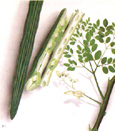| Latin Names | Moringa pterygosperma Gaertn. syn. Moringa oleifera Lam. (Moringaceae ) |
| English Names | Horse Radish, Drumstick |
| Sanskrit Names | Shigru, Shobhanjana |
| Hindi Names | Sahijna, Sainjna, Munaga |
 Distribution: Found wild in the sub-Himalayan tract, from Chenab eastwards to Sarda and cultivated all over the plains of India. Habit: M.t. is a small or medium-sized tree. The bark is thick, soft, corky and deeply fissured; the leaves, usually tri-pinnate; the leaflets, elliptic; the flowers, white, fragrant in large panicles; the pods, pendulous, greenish, triangular and ribbed with trigonous, winged seeds. Principle constituents: Pterigospermin, spirachin and banzyl isothiocyanate. Indications: Biological activity studies have confirmed the anti-inflammatory, antispasmodic and diuretic activities of the seeds. The seeds are used as antibacterial, anticholeric and anti-viral agents. Product range: Rumalaya, Septilin |
|